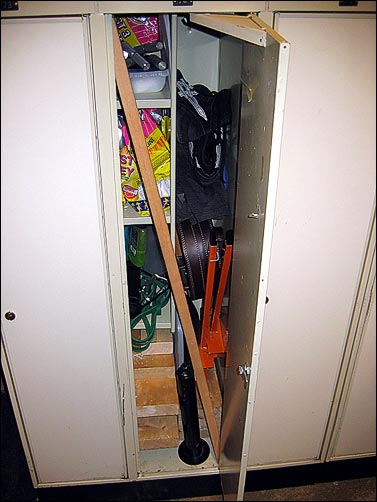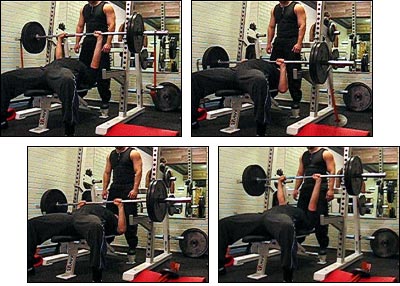(page 15)
January 30, 2005
Week 4: First visit to Metal Gym and GHR Soviet style
Monday, 24 Jan 2005: Squat/Deadlift
Ano Turtiainen, multiple World Champion and manufacturer of the legendary Metal line of equipment, is a household name in powerlifting. His gym, located on the outskirts of Helsinki, is something of a focal hub in Finnish powerlifting as the impressive gym records attest. As one of their lifters wanted to borrow my copy of The Kennelly method, I found myself on a first visit to Metal Gym suitably arranged for SQ/DL day… time to finally make a repping acquaintance with real GHRs and reverse hypers.
Metal Gym turned out to be a tad smaller than I had expected, but with all the goodies a powerlifter could expect. The back of the rectangular gym holds a squatting area equipped with specialty bars, monolift, squat stands, boxes… The chains and bands are conveniently placed as to also be reachable from the adjacent benching and power rack area. A long dumbell rack runs along much of the gym reaching a 71 kg/157 lbs crescendo near the men’s dressing room. Machines, many of them of the Metal brand, and pulleys fill up the rest of the gym with a small stretching area in one corner. There’s also a store selling Metal equipment. It was a surreal feeling to stand in the middle of this metal jungle inhabited by people doing everything from good mornings to accessory work with bands; for once, I wasn’t the only guy doing funny stuff.
After a quick change, I camped around the GHR and reverse hyper. Knowing how hard a GHR was supposed to be, it was with an empty mind that I mounted the machine and placed my feet against the ultra wide toe plate. The motion felt a lot different than the makeshift varieties, whether in lat pulleys or off stability balls, that I have done previously. For one thing, it was hitting my erectors hard since the beginning of a motion is basically an ordinary hyperextension. Secondly, it felt very dynamic and less jarring owing to the knees not being locked into place as on the makeshift varieties. Definitively easier as well, got a surprisingly good 10 reps on the first set in what I hope was good form. Hammies on fire!
In between my GHR sets, I paid attention to how other lifters where using the reverse hyper. After five sets of GHRs, I put my feet into the slings and lay the upper body down on the pad. I had no idea whether the 30 kg/66 lbs the previous lifter had left on the machine would be heavy or light, but figured I would be good to go as I had worked up to more than that on a makeshift setup (video) that by common logic ought to be heavier than the real deal. Following the example of the previous lifters, I swung my legs back and forth rhythmically for 15 easy reps before trying to gracefully get out of this pendulum of sorts. I pyramided up to 60 kg/133 lbs, the most the machine would take using 10 kg/22 lbs plates, which was really heavy on the first rep but easier once I got some momentum. It might look like the whole thing is nothing but momentum, but in fact it takes quite a lot of force to reverse the weight pulling the feet way under the bench (now I understand what it feels like when the discs are opened) and then to actually explode it back up to the top. The last one was an all out set that left my posterior chain feeling pumped to the max. This machine is really as good as they say.
Wrapped up with some ab work. I also got a lot of ideas for accessory work from seeing other lifters pound their midsection with cables and bands. At 5pm, it was rush hour and a lot of heavy squatting and benching was also taking place. After spotting a novice lifter doing 80 kg/177 lbs floor presses, Ano did speed floor presses and board presses in his shirt working up to 7 @ 270 kg/597 lbs (Ano’s log for the day). There was also some clip taking going on as one lifter maxed out on the bench with what I presume was a personal PR.
I’ll be back.
GHR: 10,8,6,6,7
Reverse-hyper:
2x15 @ 30 kg/66 lbs
2x12 @ 40 kg/88 lbs
12 @ 50 kg/111 lbs
12 @ 60 kg/133 lbs
Standing cable crunch against stability ball:
6 @ pin at 7
8,7,9 @ pin at 9
Incline sit-up: 8,7
Total training time: under an hour
Wednesday, 26 Jan 2005: Bench
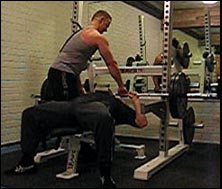 A flop. Based on how run-down I’ve been feeling lately I think I’m very possibly overtrained. Benching 100 kg/221 lbs was already stiff enough and I didn’t stand a chance with 105 kg/232 lbs. The close-grip one board presses went down the same pipe with 100 kg/221 lbs crashing down just short of lockout after a long slow-motion struggle. The thing is that I have been reluctant to take an easy week since our first child is due in two weeks (aka any time). I figure diaper changing is one of the best ways to rejuvenate a fried central nervous system.
A flop. Based on how run-down I’ve been feeling lately I think I’m very possibly overtrained. Benching 100 kg/221 lbs was already stiff enough and I didn’t stand a chance with 105 kg/232 lbs. The close-grip one board presses went down the same pipe with 100 kg/221 lbs crashing down just short of lockout after a long slow-motion struggle. The thing is that I have been reluctant to take an easy week since our first child is due in two weeks (aka any time). I figure diaper changing is one of the best ways to rejuvenate a fried central nervous system.
Bench:
worked up to 1 @ 90 kg/199 lbs
1 @ 100 kg/221 lbs
0 @ 105 kg/232 lbs
1 @ 100 kg/221 lbs (somewhat close grip)
One-board press, close-grip:
worked up to 3 @ 90 kg/199 lbs
0 @ 100 kg/221 lbs
Triceps extension on floor:
2x6 @ 40 kg/88 lbs
12 @ 30 kg/66 lbs
Wide-grip pulldown: 4x15 @ 80 kg/177 lbs
Captains of Crush work
Total training time: approximately an hour
Friday, 28 Jan 2005: Accessory
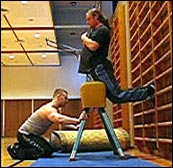 I don’t know why, but it took me a trip to a real GHR bench to remember Louie talking about how the GHR is basically a comfortable version of the original Russian setup that involved a buck horse. Did some surfing around and found this by Wake Forest University Strength Coach Ethan Reeve:
I don’t know why, but it took me a trip to a real GHR bench to remember Louie talking about how the GHR is basically a comfortable version of the original Russian setup that involved a buck horse. Did some surfing around and found this by Wake Forest University Strength Coach Ethan Reeve:
The glute-Ham piece is not a machine. It was designed by a fellow named Michael Yessis. I’m not sure what the name of the manufacturer was but we must have gotten 4 of the first [
was] ones manufactured back in 1984. They were great. Dr. Yessis basically got the idea from the Soviets during the 1970’s with many of their athletes. What they did was put a gymnastic buck horse close to those parallel wooden bars bolted to the wall in many of the gyms. The athlete would then place his belly/hips over the buck horse while placing his feet between the parallel wooden bars and feet against the wall. Some would actually take a [weighted] barbell behind their necks and let themselves down to make a 90 degree bend at the hips and do back raises. Some would raise themselves up beyond parallel by pushing their feet against the wall where they would have to bend the knees and pull themselves up with their hamstrings. A great exercise! [..] Supposedly many of the Soviet athletes would do 50-60 each day before sport training.
Earth calling! Since the school gym is located just below the fully equipped gymnasium trying this setup was easy enough. The only problem was that the buck horse had a tendency to slide away (putting a mat under it didn’t help much) thus making a personal GHR assistant necessary (thanks!). Otherwise it felt nearly exactly the same as doing them on the real deal at Metal Gym. And why wouldn’t it? The ultra wide toe plate (wall), pad (buck horse) and ankle support (parallel bars) are all there. Turns out I should probably have put my feet one notch higher to make the movement a bit harder as I got a good 15 reps on the first set. Then got excited about trying them with a bit of added resistance and worked up to a set with two minibands. If I get too sore for SQ/DL on Monday it was worth it. Anyway, here’s the coveted video of GHRs Soviet style (3.4MB). Feedback welcome.
Speaking of GHR setups, also check out Alberto’s nice makeshift one if you haven’t already (complete with video). If you don’t have an ab board with double rollers, you can always try out Keith Veit’s Floor Glute-Ham Raise involving a barbell for leg support.
GHR Soviet style:
15 @ bodyweight
8 @ miniband
3 @ 2 x miniband
2 supersets:
Incline cable sit-up: 7+1, 5+1 @ 5 kg/11 lbs
Compound stiff-legged dumbell deadlift: 3x20 @ dumbells around 14 kg/31 lbs
Total training time: about 30 minutes
January 23, 2005
Week 3: Deadlifts and dumbells
Monday, 17 Jan 2005: Squat/Deadlift
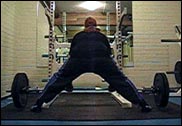 Tried extra hard to sit back on the box squats with some success. Then switched to deadlifts and worked up to a triple at 120 kg/265 lbs before making the decision that I better stop there this week. One step at a time. If the deadlifts weren’t close to a real max, the ultra-wide deads were. I put the collars way out on the bar, then got into an extremely wide sumo stance and pulled for hip and country. I’ve seen this on the Westside tapes, but it was the first time I tried it myself. The stance might have been a bit on the
Tried extra hard to sit back on the box squats with some success. Then switched to deadlifts and worked up to a triple at 120 kg/265 lbs before making the decision that I better stop there this week. One step at a time. If the deadlifts weren’t close to a real max, the ultra-wide deads were. I put the collars way out on the bar, then got into an extremely wide sumo stance and pulled for hip and country. I’ve seen this on the Westside tapes, but it was the first time I tried it myself. The stance might have been a bit on the wide wild side, but the thought that I might end up in a full split did not come to pass. In my martial arts days as an ultra-flexible black belt this would not have been a problem, but now… anyway, first time, first PR at 5 @ 110 kg/243 lbs.
Box squat, 13″ (belt): 5x2 @ 65 kg/144 lbs
Deadlift:
7 @ 60 kg/133 lbs
5 @ 70 kg/155 lbs
3 @ 80 kg/177 lbs
3 @ 90 kg/199 lbs
3 @ 100 kg/221 lbs
3 @ 110 kg/243 lbs
3 @ 120 kg/265 lbs
Ultra-wide deadlift:
5 @ 65 kg/144 lbs
5 @ 75 kg/166 lbs
5 @ 85 kg/188 lbs
5 @ 95 kg/210 lbs
5 @ 105 kg/232 lbs
5 @ 110 kg/243 lbs
Barbell side bend: 3x8 @ 45 kg/99 lbs
Total training time: 85 min
Wednesday, 19 Jan 2005: Bench
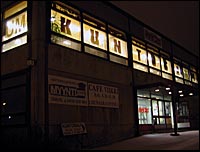 A big banner loudly proclaiming “World Class Gym” in the middle of an industrial area on the way from the school gym to the centre of Helsinki has been attracting the attention of a certain lifting duo. Last week, we finally pulled down from the highway to take a closer look. Turned out to be a medium sized gym part of the Swedish owned World Class franchise that has been there for some 15 years. Famed Finnish bodybuilder Jorma Räty, winner of the 1980 IFBB World Bodybuilding Championship middleweight title, also trains there three times a week (he was in when we were there the first time) - interestingly enough, Räty competed in powerlifting before becoming a bodybuilder and actually won the Nordic Championships in the below 90 kg/199 lbs class in 1969. The machines looked retro in a cool way, but the music was equally retro in a bad way. Supplement prices were several euro cheaper than at the other gyms and the atmosphere was friendly and close-knit. There was no rack to be found, but as we were promised a free try we decided to do today’s training there to conveniently allow me to do some long anticipated dumbell work.
A big banner loudly proclaiming “World Class Gym” in the middle of an industrial area on the way from the school gym to the centre of Helsinki has been attracting the attention of a certain lifting duo. Last week, we finally pulled down from the highway to take a closer look. Turned out to be a medium sized gym part of the Swedish owned World Class franchise that has been there for some 15 years. Famed Finnish bodybuilder Jorma Räty, winner of the 1980 IFBB World Bodybuilding Championship middleweight title, also trains there three times a week (he was in when we were there the first time) - interestingly enough, Räty competed in powerlifting before becoming a bodybuilder and actually won the Nordic Championships in the below 90 kg/199 lbs class in 1969. The machines looked retro in a cool way, but the music was equally retro in a bad way. Supplement prices were several euro cheaper than at the other gyms and the atmosphere was friendly and close-knit. There was no rack to be found, but as we were promised a free try we decided to do today’s training there to conveniently allow me to do some long anticipated dumbell work.
I had to ask some guys how to orientate among the dumbells as I found no markings on them. “Either you count the plates and add 1.4 kg/3.1 lbs for the handles or then try to make sense of the hardly discernable worn-out markings on the rack”. Did a little bit of both. Worked up to a PR double with the 41.6 kg/92 lbs dumbells on the flat bench, which I am quite satisfied with given that I haven’t done these for over a year. Then continued on to dumbell floor presses and was happy to discover that I could both get into position and out of there even with the 39.2 kg/87 lbs bells that I did the last double with.
If the regular clientele wasn’t staring when I worked the dumbells on the floor, the JM presses at least got a few members to pay attention. Followed up with some chest supported rows and then tried a funky looking row machine with the stack; much like the dumbells, the machines had only minimal markings so had no idea what I was repping with. Was pretty beat at this point as I had lived on mostly liquid the whole day - not every day you drink four protein shakes…
Dumbell bench:
5 @ 22.4 kg/50 lbs
5 @ 26.4 kg/58 lbs
5 @ 31.6 kg/70 lbs
4 @ 39.2 kg/87 lbs
2 @ 41.6 kg/92 lbs
Dumbell floor press:
8 @ 23.9 kg/53 lbs
5 @ 28.9 kg/64 lbs
5 @ 34.2 kg/76 lbs
2 @ 39.2 kg/87 lbs
JM press: 6,6,4 @ 50 kg/111 lbs
Chest supported T-bar: worked up to 3x6 @ 65 kg/144 lbs
Seated row machine: 12,10,7 @ whole stack
Total training time: just about an hour
Friday, 21 Jan 2005: Accessory
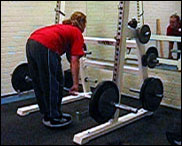 The residue of a sports massage I had at school on Tuesday was mostly gone, but felt quite stiff with humongous chest and triceps soreness from Wednesday’s dumbell session. The biceps were also a bit beat, but did the barbell curls nonetheless before moving into a superset of upper cable turns and incline sit-ups. Wrapped up with stiff-legged deadlifts off the balance board where I worked up to 6 @ 80 kg/177 lbs. By that time, the barbell was actually coming up in a fairly straight line and I no longer looked like I might eject at any time. That’s when the camera was there for this week’s video summary (3.1 MB)
The residue of a sports massage I had at school on Tuesday was mostly gone, but felt quite stiff with humongous chest and triceps soreness from Wednesday’s dumbell session. The biceps were also a bit beat, but did the barbell curls nonetheless before moving into a superset of upper cable turns and incline sit-ups. Wrapped up with stiff-legged deadlifts off the balance board where I worked up to 6 @ 80 kg/177 lbs. By that time, the barbell was actually coming up in a fairly straight line and I no longer looked like I might eject at any time. That’s when the camera was there for this week’s video summary (3.1 MB)
Lying L-flye: 3x7 @ 8 kg/18 lbs
Standing barbell curl with back support: 7,5,6 @ 40 kg/88 lbs
2 supersets:
Upper body cable turn: 2x20 @ 55 kg/122 lbs
Incline sit-up: 15,12
Stiff-legged deadlift on balance board:
6 @ 40 kg/88 lbs
6 @ 50 kg/111 lbs
6 @ 60 kg/133 lbs
6 @ 70 kg/155 lbs
6 @ 80 kg/177 lbs
Total training time: 50 minutes?
How to use the Westside Powerlifting Method for Bodybuilding
Westside Barbell is not great news on Dave DePew’s Fitness & Nutrition Hour with a long interview having been done with Louie Simmons (4 Oct 2004) and a segment on using Westside methods for American football with New Jersey Personal Trainer Joe DeFranco (13 Dec 2004). On Thursday, Louie was on again, but this time not on powerlifting but on How to use the Westside Powerlifting Method for Bodybuilding.
The impression I get from this interview is not that Louie is on a crusade to spread the gospel to bodybuilders, but rather has been invited to have his brained ticked on how he would adapt Westside for bodybuilding. Here’s a quick rundown of the interview that gets rolling after a whopping 2:30 minutes of advertisement.
Training cycle
Variety is very important for bodybuilders and the conjugated method should thus be used. Whereas Westside powerlifters would use a different bar every time they squat, bodybuilders do very well with things like doing leg presses at different gyms to hit the muscles from slightly different angles. Training should revolve around a weekly or monthly cycle at most, with nothing done for more than three weeks lest you want your body to stop progressing. “Get the large exercises out of the way first, then move into specifically what you need”.
Reps and sets
A novice bodybuilder would benefit from heavy training, as “powerlifting is basic bodybuilding” and novice bodybuilders will need to have something to cut in the first place - the stronger you are the better a bodybuilder you will be. More advanced bodybuilders would do well training around 70-80% of max.
6 reps for about 5 sets at 70% to build muscle hypertrophy
4 reps for about 5-6 sets at 80%
Stay away from the 90%, no need for it for bodybuilding
Bar speed and bands
Powerlifters generally move the bar quickly, but bodybuilders should move it slowly to eliminate momentum and work the muscle efficiently throughout the motion. Bands should be used, but fought every inch of the way with Louie recommending a 3 second or so eccentric. Tension should be kept on the muscle throughout the set; Louie mentions not allowing IFBB bodybuilder Mike Francois to lock out when he trained at Westside (Francois wrote a short column about training at Westside).
Louie reports having seen great success with using bands together with machines for bodybuilders. In the earlier interview mentioned above, Louie makes the observation that many bodybuilding machines, such as the pec deck, are heaviest at the bottom; here bands can help even out the resistance curve by making the top heavier thus working the muscle harder. In short, bodybuilders should, like powerlifters, continuously think about how to change things even for the same exercise.
Use of partials
Floor press should be used, but Louie recommends against doing too many partials as they can be a bit dangerous, especially board presses (”the only pec injuries we ever incur is doing board press”). The focus should be on full range movements such as benching with different grips.
Waist size
The interview ends with a question on whether the quest for a thin waistline will hinder strength development for bodybuilders. “So you’re not going to get a bodybuilder squat 900 pounds, that’s all there is to it.” There are bodybuilders, such as Ronnie Coleman, who are freaky strong despite having a thin waistline, but they are rather the exception than the rule. Louie recommends a lot of belt squatting and exercises without a bar on the back to keep waist size down. In conclusion, he notes that a lot of bodybuilders have larger waists than they say they do, but the size of their shoulders and legs tends to obscure this fact.
Now, where is the blog dedicated to Westside bodybuilding?
January 20, 2005
January 18, 2005
The Reinvention Tour
Alberto Caraballo, a familiar face over at GoHeavy.com and a reader of this humble blog, opened his own shop aptly titled The Reinvention Tour. In my twisted mind, I take the name as a gentle reminder that lifting is really about rediscovering what so many lifters before you have learned for themselves. Be that as it may, yet another supreme reason to get serious about RSS.
January 17, 2005
Week 2: Ride the lightning
Monday, 10 Jan 2005: Squat/Deadlift
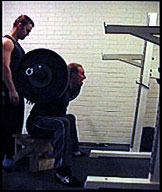 The days of sleeping 12 hours a night are over. Sleep deprivation draws near.
The days of sleeping 12 hours a night are over. Sleep deprivation draws near.
If I had to pick one word to describe today’s workout, it would be “reassuring”. After doing the usual speed work, this time with 60 kg/133 lbs, I pyramided up to a 110 kg/234 lbs slightly below parallel box squat (13″). This rep looked fairly good; in fact, sat back a lot more than on the speed work. Embarrassing as it is, this is only 5 kg/11 lbs less than my recorded pre-injury PR off the very same box. Wisely decided to leave PR breaking for the next heavy box session two weeks from now, because a) I was squatting outside the rack to accommodate the widened stance and b) play it safe from a back standpoint (although I do feel it can now take most anything I can dish out in good form on the box). Since I’m just returning to heavy squat/deadlift training, I hope I could reap some beginner’s gains this year and see a hefty increase in weights. I need it before I outbench my squat. Now THAT would be embarrassing. Three plates off this box is my next goal.
Box squat, 13″ (belt):
5x2 @ 60 kg/111 lbs
worked up to 1 @ 110 kg/243 lbs
4 @ 95 kg/210 lbs
Good mornings off pins (mid-stomach):
worked up to 10 @ 80 kg/177 lbs
Hanging leg raise: 10,7,7,6
2 supersets:
Rolling Thunder reverse cable curl: 6,6 @ 20 kg/44 lbs
Captains of Crush: 8 @ I + negatives with II
Total training time: about an hour
Wednesday, 12 Jan 2005: Bench
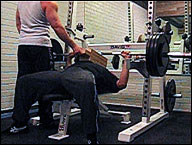 Oh la la! Had been feeling ready to bench for much of last week, but waking up today I had some VERY tender pecs (felt like the pectoralis minor). What is strange is that I have no idea what caused it, the only thing I can come up with are the hanging leg raises I did on Monday… and even that takes a leap of imagination involving hunched shoulders and possibly green men from Mars. I wanted to go for a new bench max today, but instead felt obliged to get the sore pecs out of the equation with three board presses. I don’t regret it for a second, because I put up a new shiny PR by doing an easy 120 kg/265 lbs before failing with 130 kg/287 lbs. After a year of nothing, I am in heaven. In a matter of a couple of weeks, 100 kg/221 lbs has gone from being something big to a good weight to stop over by to gauge the form of the day. Continued with some floor presses, but was fairly beat after having pyramided down following the 130 kg/287 lbs attempt.
Oh la la! Had been feeling ready to bench for much of last week, but waking up today I had some VERY tender pecs (felt like the pectoralis minor). What is strange is that I have no idea what caused it, the only thing I can come up with are the hanging leg raises I did on Monday… and even that takes a leap of imagination involving hunched shoulders and possibly green men from Mars. I wanted to go for a new bench max today, but instead felt obliged to get the sore pecs out of the equation with three board presses. I don’t regret it for a second, because I put up a new shiny PR by doing an easy 120 kg/265 lbs before failing with 130 kg/287 lbs. After a year of nothing, I am in heaven. In a matter of a couple of weeks, 100 kg/221 lbs has gone from being something big to a good weight to stop over by to gauge the form of the day. Continued with some floor presses, but was fairly beat after having pyramided down following the 130 kg/287 lbs attempt.
Next week, I will put in some much anticipated dumbell work over at another gym to give the system a rest from all the heavy singles. Then time for a new bench max I suspect.
Three-board press:
worked up to 2 @ 100 kg/221 lbs
2 @ 110 kg/243 lbs
1 @ 120 kg/265 lbs
0 @ 130 kg/287 lbs
0 @ 125 kg/276 lbs
0 @ 122.5 kg/271 lbs
Close-grip floor press:
worked up to 3 @ 90 kg/199 lbs
Lying dumbell extension: 7,5 @ 18.5 kg/41 lbs
One handed-lat pulldown (kneeling):
2x6 @ 40 kg/88 lbs
2x12 @ 30 kg/66 lbs
Total training time: about 70 minutes I guess
Friday, 14 Jan 2005: Accessory
Today’s workout was plain fun (aren’t they always?) as I discovered stiff-legged deadlifts on the balance board (found them in my head). If you’re looking for a very functional low back/hamstring movement that feels like deadlifting in a rowing boat in the middle of a storm, this is IT. Don’t expect the weight to always come up in a straight line, it won’t. Definitively not for core beginners. Will take a clip of these at some point. For now, you will just have to live with this week’s clip (5.6MB).
Also did some fun stuff for the biceps. Haven’t done down the racks since I was a bodybuilder, but now I am shamelessly employing bodybuilding methods to pack some size unto the front of my arms to match the triceps that march to the tune of relentless pressing. In case you didn’t now, down the rack involves working your way down the dumbell rack by picking up a lighter pair of bells every time you hit failure. I usually keep dropping till I reach a weight that I can suddenly crank out 10-20 reps with. At that point the muscle has usually gone numb and could use an oxygen break.
Pulldown to head: 3x15 @ 70 kg/155 lbs
Incline dumbell curl, down the rack (all sets below done in succession without rest):
5 @ 21 kg/46 lbs + 1 @ 18.5 kg/41 lbs + 3 @ 16 kg/35 lbs + 3 @ 13.5 kg/30 lbs + 6 @ 10 kg/22 lbs + 10 @ 8 kg/18 lbs (total: 28 reps)
4 circuits of:
Standing cable crunch with 3 isometric holds of 5 seconds: 5 @ 30 kg/66 lbs / 7,3,3 @ 40 kg/88 lbs
Upper body cable turn: 25,25,25,25 @ 50 kg/111 lbs
Stiff-legged dead on balance board: 10,10,10,10 @ 50 kg/111 lbs
Rolling Thunder holds: 2x30 kg/66 lbs
Total training time: 52 minutes
Circuit 1: ? min, circuit 2: 5:05 min, circuit 3: 3:30 min, circuit 4: 4:20 min
January 12, 2005
English section at Westsidebar.net
The Finnish powerlifting forum Westsidebar.net just started a few English sections (scroll down) in close collaboration with Metal (Ano will be around). In my opinion, this forum is among the best out there (and that’s putting it fairly mildly) and a nice alternative voice to the US dominant forums (prepare for culture shock). It will be interesting to see how regular forum members will get involved with the English side of things. Only one way to found, eh? Everyone’s invited.
January 11, 2005
Everybody do the leg press!
Scott Koffman filed a $9.2 million suit Thursday in U.S. District Court against BYU and a conditioning coach. He claims he suffered three herniated discs from being forced to use too much weight while performing an elevated leg press in September 2001. Koffman claimed when he tried to take off some weight, he was stopped by Justin McClure, the assistant strength and conditioning coach. He alleges McClure, who is named in the lawsuit, called him a vulgar name, added another 100 pounds and ordered him to lift. Koffman suffered the spinal injury on his first repetition, the lawsuit contends.
Pitcher claims injury ended pro prospects (August 27, 2004)
The above story, pitiful in its own right, prompted Razorman to post the safe way to use a leg press to the Dr. Squat message board.
1) Take leg press machine.
2) Melt into molten steel.
3) Pour into weight plate molds - or preferably, extrude into cylinders and mill to precise tolerance weight plates.
4) Recover some of the remaining steel and extrude into a bar.
5) Cut knurling into bar.
6) Place bar over shoulders after loading plates onto bar.
7) Squat, like God intended.
I learned about this while reading Skinny Bastard Training Log and promptly realized that this gospel needs to spread like wildfire for the sake of all lost gym souls. Speaking of which, hopefully Koffman got himself a ball and a balance board… career over? Why? ![]()
January 9, 2005
Desperate times call for desperate measures
Have you ever had the feeling of just being off to bed only to notice that there are a) no eggs, cottage cheese or meat in the fridge and b) no tuna on the shelves? With increasing desperation you scan for the less obvious stuff such as canned beans. None found. Just as you start to contemplate whether to drink a liter of milk or go through the effort of frying up some meat from the freezer, you remember that old bag of yucky whey protein powder that refused to mix with anything, at least in a shaker. Some blueberries from the freezer, milk and a mixer to the rescue! Aaah, now one can retire knowing that protein, probably well past its best before date, is floating in the veins. Good night.
Week 1: Weight releasers and unstable curls
Training week condensed, take 1. Will prefix all the workout summaries with the week of the year, perhaps I can fool some new visitors into thinking these are the number of weeks I have been training. Will also be posting only one video even if there is footage from several days, look for it at the end of the summary or try clicking any images from training sessions, I usually link those straight to video footage if available.
Monday, 3 Jan 2005: Squat/Deadlift
Did the usual speed squatting, this time with a newly acquired powerlifting belt. No, I’m not about to budge just yet from my beltless lifting ethos but will use it on box squats to facilitate correct midsection tightening as prescribed by Dave Tate:
First, expand your abdomen as much as possible. When you pull air into your body it should be into the diaphragm, not the chest. Expand you belly and push it out against your belt. This will stabilize and support the lower back and not elongate the spine. If you’re having a hard time trying to figure this out, then wear your weight belt one notch loose and push into it with your belly so it becomes tight.
With the new routine dictating a pull every other week, I did rack pulls next. Worked up to a modest 110 kg/243 lbs from below the knees. Not that I couldn’t have done more, but this is the heaviest loads I’ve placed on the low back in a loooong time, so I’m doing the sensible thing here for once.
Box squat, 13″: 5x2 @ 50 kg/111 lbs (belt)
45′ hyperextension with cable: 3x10 @ 70 kg/155 lbs
Barbell side bend: 3x8 @ 45 kg/99 lbs
Total training time: about an hour
Wednesday, 5 Jan 2005: Bench
Ever since last week’s two-board press max effort rollercoaster, I’ve lived in suspense. The triceps got predictably mega-sore and it was questionable whether the sauna-massage-tiger balm regime would do much to make them ready for another bench session in seven days. Come Wednesday I still had some light soreness left, but having paid a steep 85 euros for a pair of weight releasers I felt ready to rumba. The primary target of the day was a new close-grip PR of 105 kg/232 lbs with an added 10 kg/22 lbs on the releasers for a 115 kg/254 lbs descent. After I, presumably, would make that weight I would ditch the releasers and feel the lightness of 107.5 kg/238 lbs. Thus, besides making my body acquainted with a bit heavier weights, the releasers would also serve a grand psychological purpose (releasers can also be used for speed work to build reversal strength).
Started adding the 10 kg/22 lbs releasers (2.5 kg plates + 5 kg releasers) at 80 kg/199 lbs. Once I hit 100 kg/221 lbs, a new PR weight on the close-grips, I first started doubting the descent as I had never lowered 110 kg/243 to my chest before and the slight swaying of the releasers could potentially take me seriously out of groove. Not surprisingly, my fears led to an overspotted first set but it served to reassure me that 110 kg/243 lbs was no problem. With no spotting hands between me and the bar this time, I went for it again. After the releasers jumped off, the bar first dipped left as I pushed up then it went right (if you look closely at the picture series above, you’ll see why). I was nowhere near my optimal groove, but got it up. Then attempted 105 kg/232 lbs with a 115 kg/254 lbs descent, but it didn’t go. Neither did 105 kg/232 lbs without releasers. Tried some board presses for the secondary movement, but shoulders were too fried so went straight into some pressdowns instead.
The initial disappointment of only making 100 kg/221 lbs was quickly replaced by contentment. After all, the suboptimal groove of the lift and the extra heavy descent made this 100 kg/221 lbs a tad special. As for the descent, I’m pretty sure I could have handled 125 kg/276 lbs to 135 kg/299 lbs (one article I found by Matt Brzycki stated that a fresh muscle can usually handle about 40% more on the eccentric lowering phase). If going for a truly max lowering, which is probably not needed and a sure shoulder killer, there should be ample safety precautions as the weight will more or less free fall down on you if you can’t handle it. Take whatever your max bench is, then add 40% more. Scared yet?
I’ve linked to it before, but for a bit more hardcore weight releaser footage than my video (4MB), see this clip of Ano squatting with bands and releasers.
Close-grip bench press with weight releasers:
worked up to 70 kg/155 lbs
1 @ 80 kg/177 lbs + 10 kg/22 lbs releasers
1 @ 90 kg/199 lbs + 10 kg/22 lbs releasers
1 @ 100 kg/221 lbs + 10 kg/22 lbs releasers
0 @ 105 kg/232 lbs + 10 kg releasers
0 @ 105 kg/232 lbs
Pressdown in lat pulley: 10,10,6 @ 35 kg/77 lbs
Wide-grip pulldown: 3x10 @ 90 kg/199 lbs
Total training time: 45 min
Friday, 7 Jan 2005: Accessory
Had a very short night, a morning nap really, and having breakfast an hour before a 2pm workout was not optimal. To save my precious breakfast, I opted for supersets instead of the normal circuit. But before that I did standing cable curls on the balance board for the first time… a bit shaky, but easier than with free weights since the cable does provide a bit of support. These, along with Måns’s ingenious weighted spiderman rows and Wednesday’s weight releaser action, are of course on this week’s video (4MB).
Rope pull: 3x10 @ 45 kg/99 lbs
Cable curl standing on balance board: 4x10 @ 60 kg/133 lbs
2 supersets:
Incline sit-up: 12,11
Hyperextension on stability ball: 12,8 @ 15 kg/33 lbs
2 supersets:
Lower cable twist: 12,12 @ 35 kg/77 lbs
Arm and leg extension kneeling on stability ball: 10,10
2 supersets:
Plate curl: 3 @ 10 kg/22 lbs, 12 @ 7.5 kg/17 lbs
2″ wooden block pinch grip: 8,8 @ 15 kg/33 lbs
Total training time: 63 min
